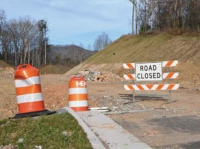Jackson leaders take a bold – and wise – step
Jackson County took the first step this week to ban new subdivisions until it can write an ordinance to control the proliferation of new developments within its borders. By doing so, its county commissioners proved they have a mettle that is too often lost on elected officials who worry too much about re-election and too little about their constituents.
Banning new subdivisions while writing an ordinance would put Jackson County in a unique place. For one, it’s the first time a county in the region has taken such a strong step. That alone speaks volumes. Two, county leaders would be able to take some time — the moratorium would last six months unless commissioners decide to lift it earlier — to write an ordinance that will help residents cope with growth.
Time and again, it has been proven in Western North Carolina and elsewhere that leaving development solely to the people who stand to profit directly from it is a bad idea. Those building subdivisions don’t look at the big picture, only at their little microcosm. Traffic becomes congested, infrastructure is strained, health and human services can’t keep up with growth, valuable real estate is lost or its value compromised, and conflicts erupt between neighbors and newcomers.
A subdivision ordinance won’t solve all these woes, but it can help soften the effect of many of them. It can also dictate some terms to developers, restrictions that might force them to cluster homes or keep roadways off slopes that are too steep for rescue and fire vehicles. Planners can force landowners to keep waterways clear of sediment by requiring buffers, or they can provide incentives for those who incorporate open spaces, community farms and forestland into their new communities. There are many creative ways being used around the country to encourage developers to take new approaches to building neighborhoods.
And, of course, sometimes residents of an area and their leaders simply want to stop — or at least slow — growth. Sometimes, enough is enough. Between 2000 and 2005 in Jackson County, there were nearly 5,500 new lots created in 24 subdivisions. Between 1997 and 2002, farmland acreage was reduced by 20 percent, from 20,707 acres to 16,399.
Related Items
Jackson County is unique in many ways. Most important to this debate is that it doesn’t have as much land owned by the federal government. Between Cashiers and Sylva is a beautiful area of coves, creeks and mini-watersheds that is vast and secluded. Most of it is privately held, and it is attracting lots of attention. Barkers Creek, the area along U.S. 441 toward Franklin and many other communities are just as attractive to big-time developers.
We won’t mince words. Businesses like The Smoky Mountain News are among those who make money from the people who develop these tracts. Look through our paper and you’ll see their advertisements. Lots of the recent growth in recent years in the mountains has been tied directly to the construction industry. We don’t subscribe to the simple view that developers are evil people come here to rape the land. It’s much more complicated than that.
But that is exactly why counties and towns need to spend time, money and energy in developing land-use plans that are comprehensive and tailored to their particular needs. We can’t take away the attributes that make these mountains so desirable. All that’s left, then, is to step between the money and the land and steer development wisely. In particular, it needs to be done in a way that most mountain residents can be happy with. That’s a tough challenge, but we’re ecstatic that Jackson County leaders are taking it on.









